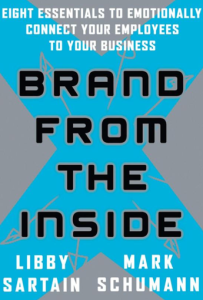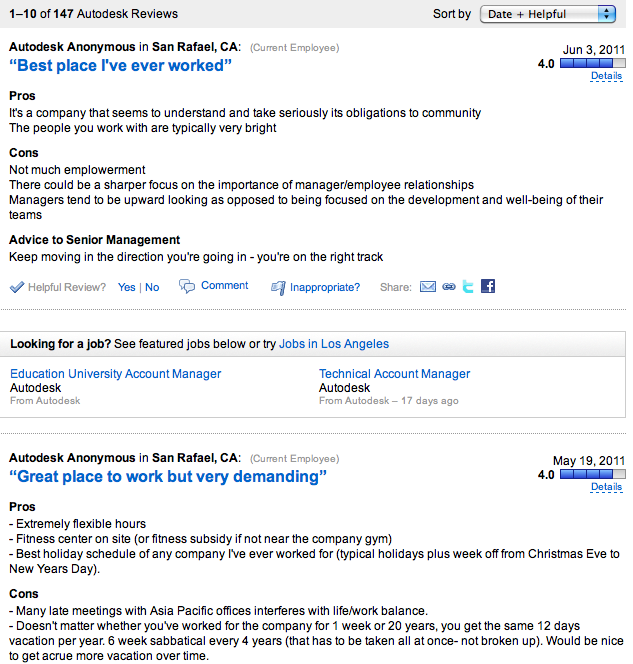(This article, co-authored with Amy McKee, director, global talent acquisition, at Autodesk, is a greatly abridged version of an in-depth article also co-written with McKee and published in the June Journal of Corporate Recruiting Leadership.)
There has never been a better time to be a recruiter.
What we do can quite literally make or break a company. If we can’t attract and retain the best staff, then our company will lose ground rapidly, financials will suffer, and it will die a slow painful death.
Recruitment is undergoing a change. Not just a small scale evolution but a fundamental seismic shift. A change that will see the recruiting landscape change forever. A change that will see many traditional recruiters falling behind and being replaced by new, differently skilled recruiters, ready for the challenges of Recruitment 3.0.
Indeed, it is not only recruiters who will be found obsolete in Recruitment 3.0 but many of the current recruitment leaders in top companies today, criminally not preparing their Fortune 500 Companies for the new realities of a changing recruitment landscape. Recruitment leaders’ version 1.0 are real, out there in abundance, so obsessed in process and introverted to the point of not seeing outside the window of their office, damaging the prospects of the very company they seek to serve.
Why the need for change?
 The current global recruitment landscape is changing. The global war for the best talent is real, (note the use of “best”); talent is geographically mobile and happy to move for the best job; talent is more demanding, not only in pay but career progression and training and development; the experienced talent pool is shrinking in volume; convergence of talent, as recruiters fighting in a smaller talent pool attract candidates across different sectors; the graduate pool is scarily becoming “less skilled” as graduates come out of universities with watered-down degrees, ill-preparing them for working life; talent is less loyal and happy to switch companies every two years on average; competitors are getting smarter in mapping out talent pools and attracting your staff away; and recruitment agencies are failing to be creative in attracting unique talent to their databases, hence perpetuating “recruitment chess” of the same talent across companies.
The current global recruitment landscape is changing. The global war for the best talent is real, (note the use of “best”); talent is geographically mobile and happy to move for the best job; talent is more demanding, not only in pay but career progression and training and development; the experienced talent pool is shrinking in volume; convergence of talent, as recruiters fighting in a smaller talent pool attract candidates across different sectors; the graduate pool is scarily becoming “less skilled” as graduates come out of universities with watered-down degrees, ill-preparing them for working life; talent is less loyal and happy to switch companies every two years on average; competitors are getting smarter in mapping out talent pools and attracting your staff away; and recruitment agencies are failing to be creative in attracting unique talent to their databases, hence perpetuating “recruitment chess” of the same talent across companies.
Those are a lot of dynamics at play.
So are many of the Fortune 500 recruitment leaders applying Recruitment 1.0 solutions to the new world? Let’s first look at the core philosophical differences between traditional recruiting and Recruitment 3.0.
The Core Philosophy of Recruitment 3.0: Not everyone is looking
This is the fundamental underlying core essence of Recruitment 3.0. Not everyone is looking for a job. Different market research exists but the benchmark seems to suggest that, for any given role, only 10% of relevant/experienced talent is actively looking for a role at any given moment in time.
That means that 90% of candidates relevant for your role/s are not engaged in job searches. The best candidates typically among them.
Hence in a candidate short market, with a host of competition for particular skill-sets, the global war for the best talent is being fought out among 10% of active job seekers.
So ask yourself this: Why is my recruitment leader focused on using recruitment agencies, posting on job boards, and CV searching, when they are not reaching out to the 90% non-active segment, which could include the best candidates?
The Core Philosophy of Recruitment 3.0: Everyone is a potential candidate or brand ambassador, even your consumers
 At the core of the philosophy of Recruitment 3.0 is the definition of a candidate. We typically define one as someone who has nominated themselves to be part of an election process. A voluntary act.
At the core of the philosophy of Recruitment 3.0 is the definition of a candidate. We typically define one as someone who has nominated themselves to be part of an election process. A voluntary act.
But at what point does someone volunteer themselves to be a candidate? When they see your advertisement? When they apply to your advertisement? When you interview them?
So if they are not a candidate until they volunteer themselves, what are they?
They are your average person sitting drinking a coffee in Starbucks, or leading a team at work, speaking at a conference, running down the road, watching TV, or having a pint of the finest ale down the local pub.
What turns a regular person into a candidate? A whole host of reasons. Not being recognized for their contribution at work, poor relationship with their manager, lack of career development, lack of challenging work, poor remuneration.
A company either waits for the moment that someone presses the button and turns themselves into a candidate and then jumps on them, or makes a proposition that is attractive and tempts them into candidacy.
Hence at the core of Recruitment 3.0 is that everyone is a candidate. And it is up to us to create candidates not wait.
The Core Philosophy of Recruitment 3.0: employment brand is pivotal to your success in talent acquisition
What is a brand? Simply a person’s gut feel to a product, service, or organization. Many companies spend millions on their corporate brand identity. But they spend little or no time on defining an employment brand. Indeed some companies are so arrogant they believe their corporate brand is enough to attract people to work for them. Amazing how many well-known corporate brands are nightmares to work for as the arrogance of senior leadership and management feel it is a career pleasure to work for them and spend no time on developing/retaining their core assets.
 What is an employment brand? Libby Sartain brilliantly defines it: How a business builds and packages its identity, from its origins and values, and what it promises to deliver to emotionally connect employees so that they in turn deliver what the business promises to customers. Building the employment brand from inside the business, with a consistent substance, voice, and authenticity, may be the most powerful tool a business can use to emotionally engage employees.
What is an employment brand? Libby Sartain brilliantly defines it: How a business builds and packages its identity, from its origins and values, and what it promises to deliver to emotionally connect employees so that they in turn deliver what the business promises to customers. Building the employment brand from inside the business, with a consistent substance, voice, and authenticity, may be the most powerful tool a business can use to emotionally engage employees.
Note some of those terms. Particularly “emotion” and “engage.” Big new terms for recruiters to adjust to and understand.
Take a look at your employment brand. Can you define it? Probably less than 3% of the Fortune 500 has a clearly defined EVP.
Put simply, imagine going into a supermarket, seeing lots of product on the shelves, but all of it looks the same and is in white packaging. Would your company allow its product/service offering to be so bland and not stand out? So why allow the employment brand to be that white, blank packaging that is not unique and stand out?
Employment brand is a vast subject and in the full article in the Journal cutting-edge ideas are given on how to impact on the full employee experience. But consider this.
Does recruiting have a role in PR?
If your company wants to reach out to new talent, unfamiliar with your brand, and build employment brand recognition on a wider scale, then PR and use/partnership/manipulation of the media is critical.
Google your recruitment leader’s name today, alongside your company name. What do you see? The vast majority of Fortune 500 recruitment leaders have no identity on search engines. They don’t promote their company brand. They don’t speak at events. Recruitment 3.0 leaders will be fired for not being a proactive champion of their company as a great place to work.
The Core Philosophy of Recruitment 3.0: The Psychology of People
People are naturally social. They love to talk. Engage. Gossip. They are hungry for information.
When forming a relationship, they want honesty, authenticity, integrity, transparency and communication. Two-way communication.
A good salesperson knows this. Build a relationship. Relationships sell.
When looking at employment branding, people want relationships with people, not faceless, bureaucratic companies.
So the key is allowing people to have transparent, trustworthy, two-way communication with your company. And yes, a relationship.
The Core Philosophy of Recruitment 3.0: You are not in control of what people are saying
 Everyone’s talking about your company, whether your executive leadership like it or not. Be it your products, services or leaders … and, yes, even your company as a place to work. Google today: “Working for *****” (insert your company name). You can see what people are saying on blogs, websites, and Twitter feeds. Log into Glassdoor.com. Those conversations are taking place right now, (sadly few are taking place on official company channels/sites, as many don’t allow or are closed to any form of engagement or comments).
Everyone’s talking about your company, whether your executive leadership like it or not. Be it your products, services or leaders … and, yes, even your company as a place to work. Google today: “Working for *****” (insert your company name). You can see what people are saying on blogs, websites, and Twitter feeds. Log into Glassdoor.com. Those conversations are taking place right now, (sadly few are taking place on official company channels/sites, as many don’t allow or are closed to any form of engagement or comments).
People love to talk. The difference in 2011 is that they tell their friends about their views via larger mass communication channels and their friends are now large communities. Word of mouth spreads like wildfire.
So why are so many companies not adjusting to this reality? Corporate PR and Marketing are educated in a specific old school way; it’s their DNA to just push out a message and leave it out there, not to engage in conversation. Heaven forbid, it could distort the core message and can even lead to the message being overturned!. That’s a massive miscalculation in 2011. Not engaging with communities is harming many corporates.
Yes. This is pretty scary for modern corporates. Business can no longer control what is said. Today there is a shift in the balance of power. Technology is shifting the power away from the publishers, media, the elite, corporate to us, the people. Recruiters need to embrace this, as must as their PR & Marketing departments.
Those companies that listen, are humble, have “official channels” that are open and seek to solicit the opinions of their community will be the winners of Recruitment 3.0. But how do companies listen and seek opinions?
The Core Philosophy of Recruitment 3.0: Building relationships and communities is key
The growth of the power of the Internet and communication is unstoppable. The “Twitter revolutions” in the Middle East show that people are grasping and using technology to communicate their views, much to their anger of the elite.
Social media and networks are on fire. Whatever you look at — Facebook, YouTube, LinkedIn, Twitter — the growth stats and usage is phenomenal. People talking, 24/7.
Why have so many recruiting leaders and Fortune 500 companies failed to grasp the importance of social media and engaging and building talent communities?
Yes, many companies can beat their chest and proclaim they have a presence on Facebook or Twitter but they are using them in a style reminiscent of Recruitment 1.0 “post, pray, and spray.”
![]() Leap onto some corporate Twitter feeds today. You will see that many are de-facto job boards. A long list of jobs with a hyperlink back to their jobs site. Try replying and communicating with that company and you will more often than not never receive a reply. Indeed some corporate Twitter feeds post more jobs in the course of a week than they have followers.
Leap onto some corporate Twitter feeds today. You will see that many are de-facto job boards. A long list of jobs with a hyperlink back to their jobs site. Try replying and communicating with that company and you will more often than not never receive a reply. Indeed some corporate Twitter feeds post more jobs in the course of a week than they have followers.
Let’s cut to the key point. Social media is not about immediate bums on seats. It will not lead to immediate mass new hires or pipeline. It is a vehicle to take people on a journey. A journey that people will board at different junctures. But when reaching the destination, the goal is that they are either someone who wants to work for your company or that they are a Brand Ambassador. Brand Ambassadors are people who may not want to work for you, but they engage in your community, participate in discussions, sing your praises to friends and act as a champion of your brand.
Why do people join at different points on the destination? Some people know your brand and have a feel for your company and hence can reach the end of the journey quickly. Others may not have even heard of your company and hence a long journey of discovery and education awaits. The key is how you attract their attention and how you engage with them.
Social media is a great vehicle to take people on that voyage of discovery and hence asking yourself some deep questions about why social media is key. Questions like……
- What’s the purpose of our social media sites?
- Who is the core target audience?
- What experience and takeaways do we want our community to have?
- Will these sites generate repeat visitors?
- How are our sites “sticky” so people want to stay on them?
- What’s the difference between our social media sites and our jobs board?
- What’s the word of mouth likely to be on our social media?
The Core Philosophy of Recruitment 3.0: Recruitment is boring
Yes. Sorry folks. Recruitment is boring.
Ask yourself how many recruitment job sites or recruitment social media sites you visit when you are not looking for a job. The answer is maybe zero. When people are looking for a job they will happily visit your jobs board and social media feeds but if they are happy in their job — that 90% of non-active candidates — sorry, but they won’t visit your sites regularly. Unless they are particularly dull people.
So, goal is to create engaged communities who spread the word. That means that any communication has to be two-way and interesting/informative/entertaining to the reader.
The full article in the Journal gives some great ideas on engagement.
The New Recruitment 3.0
Recruitment 3.0 is about building engaged communities, telling a story, listening, discussing and fostering an emotional attachment with new talent.
Recruiter 1.0 and 2.0 will be a dying breed in the coming months and years, replaced and thrown on the scrap heap by Recruiter 3.0 who can combine a range of skills including:
- PR & messaging
- Marketing
- Direct Marketing
- Market segmentation
- Candidate Relationship Management
- Sales
- Presentation and Communication Skills
Are your recruiters ready?
Is your recruitment leader ready?
All will unravel over the coming months and years and we will see which companies can be transparent and build engaged communities. Will yours?
 As I mentioned at the outset, “A Guide to Recruitment 3.0” by myself and Amy McKee, (Global Director of Talent Acquisition of Autodesk), is published in the June edition of the Journal of Corporate Recruiting Leadership, now available to subscribers. For those who wish to read it, email ERE Editor in Chief Todd Raphael at todd@ere.net and request a copy. This paper is an insight into the strategy of Autodesk Talent Acquisition in the next 12 months in which much will change and be updated to reflect this philosophy. Please feel free to judge us against our own criteria in the coming months.
As I mentioned at the outset, “A Guide to Recruitment 3.0” by myself and Amy McKee, (Global Director of Talent Acquisition of Autodesk), is published in the June edition of the Journal of Corporate Recruiting Leadership, now available to subscribers. For those who wish to read it, email ERE Editor in Chief Todd Raphael at todd@ere.net and request a copy. This paper is an insight into the strategy of Autodesk Talent Acquisition in the next 12 months in which much will change and be updated to reflect this philosophy. Please feel free to judge us against our own criteria in the coming months.